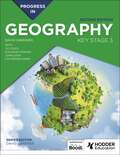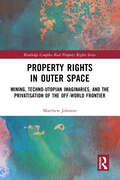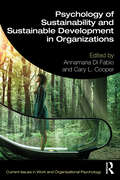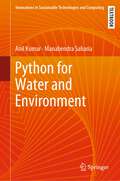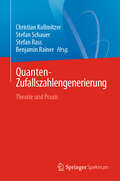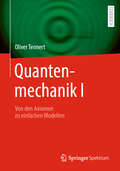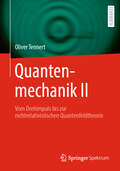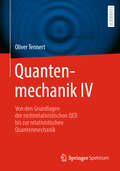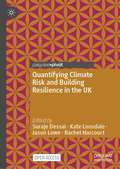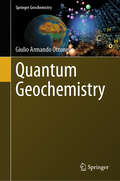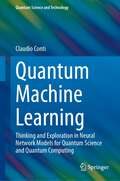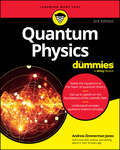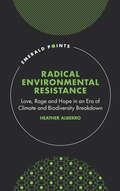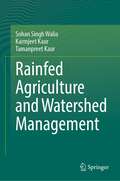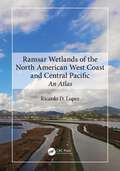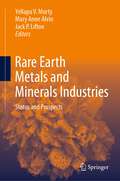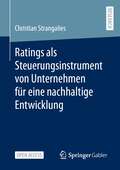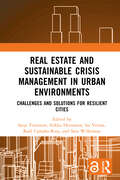- Table View
- List View
Progress in Geography: Key Stage 3, Second Edition
by David Gardner Jo Coles Catherine Owen John Lyon Eleanor BarkerPut progression at the heart of your curriculum with this hugely popular KS3 course from David Gardner, a leading authority in the Geography community.Fully reviewed and updated - with three new units - this forward-thinking course will fascinate young geographers, incorporating many diverse voices and exploring 'big ideas' such as place, the Earth's systems, the impact of colonialism and the complexities of development.> Choose the most cost-effective course. With 180 ready-made lessons in a single book, Progress in Geography provides a full three-year KS3. The free accompanying Progression Framework maps progress from Year 7 to Year 9, across the National Curriculum and towards the GCSE Assessment Objectives.> Ensure progress in geographical skills, knowledge and understanding. Every lesson and every unit builds upon prior learning and links to future learning, fully embedding geographical enquiry. Each double-page spread represents one lesson, with rich geographical resources, up-to-date data and case studies for pupils to interpret, analyse and evaluate.> Align with Ofsted's expectations. Curriculum expert David Gardner has fully integrated disciplinary, substantive and procedural knowledge, as recommended in Ofsted's 2023 Geography Subject Report and the GA Curriculum Framework.> Assess and demonstrate pupil progress. Ideal for formative assessment, lesson activities create a stepped approach to enquiry learning, guiding pupils through the geographical data as they answer each lesson's enquiry question. End-of-unit review lessons create a reflection point, facilitating medium-term summative assessment and giving a broader view of progress.> Lay firm foundations for GCSE. Key vocabulary, command words and concepts are introduced gradually, preparing pupils for the content and question types they will encounter at GCSE, with a particular focus on analysis and evaluation, plus newly added decision-making activities.
Property Rights in Outer Space: Mining, Techno-Utopian Imaginaries, and the Privatisation of the Off-World Frontier (Routledge Complex Real Property Rights Series)
by Matthew JohnsonThis book explores the role of private mining rights in the utopian imaginary of space colonisation. It presents a transdisciplinary account of the new and evolving legislative frameworks that have been established in anticipation of commercial exploitation of the mineral resources of the off-world frontier. Written in an engaging style, the book investigates a novel case study in the history of capitalism and 'the commons': the emergence of a nascent space mining industry, undergirded by a contentious legislative framework. In 2015, the US passed laws that would recognise the claims of US corporations to own and sell space resources. This unilateral act of pre-emptive law-making would appear to contravene the terms of the UN Outer Space Treaty (1967), which declared that the exploration and use of outer space should be ‘for the benefit of all mankind’ and ‘not subject to national appropriation’.Using this central dynamic between privately held mining rights and outer space as a 'global commons', Matthew Johnson constructs an historical sociology of space mining – from the deep historical roots of common and private property to the contemporary networks of neoliberalism that have engaged with the commercialisation of space activity. The anticipatory expansion of private property claims beyond the Earth both resonates with and problematises the ‘terrain’ of political history, such as the tensions between states and markets, public law and private power, ‘the commons’ and exclusive property. The emerging cosmopolitics of off-world private property mirrors (and is often explicitly embedded within) neoliberal geopolitics, prompting urgent questions about how we can reaffirm principles of democracy and ‘common heritage’ in the international laws of Earth and space. This book is compelling reading for anyone interested in the social study of space, law, economics, technology, politics and property rights.
Property Rights in Outer Space: Mining, Techno-Utopian Imaginaries, and the Privatisation of the Off-World Frontier (Routledge Complex Real Property Rights Series)
by Matthew JohnsonThis book explores the role of private mining rights in the utopian imaginary of space colonisation. It presents a transdisciplinary account of the new and evolving legislative frameworks that have been established in anticipation of commercial exploitation of the mineral resources of the off-world frontier. Written in an engaging style, the book investigates a novel case study in the history of capitalism and 'the commons': the emergence of a nascent space mining industry, undergirded by a contentious legislative framework. In 2015, the US passed laws that would recognise the claims of US corporations to own and sell space resources. This unilateral act of pre-emptive law-making would appear to contravene the terms of the UN Outer Space Treaty (1967), which declared that the exploration and use of outer space should be ‘for the benefit of all mankind’ and ‘not subject to national appropriation’.Using this central dynamic between privately held mining rights and outer space as a 'global commons', Matthew Johnson constructs an historical sociology of space mining – from the deep historical roots of common and private property to the contemporary networks of neoliberalism that have engaged with the commercialisation of space activity. The anticipatory expansion of private property claims beyond the Earth both resonates with and problematises the ‘terrain’ of political history, such as the tensions between states and markets, public law and private power, ‘the commons’ and exclusive property. The emerging cosmopolitics of off-world private property mirrors (and is often explicitly embedded within) neoliberal geopolitics, prompting urgent questions about how we can reaffirm principles of democracy and ‘common heritage’ in the international laws of Earth and space. This book is compelling reading for anyone interested in the social study of space, law, economics, technology, politics and property rights.
Psychology of Sustainability and Sustainable Development in Organizations
This volume answers calls for improving sustainability and sustainable development in organizations from a psychological point of view. It offers a range of perspectives on the current research in the psychology of sustainability and sustainable development to highlight effective ways of improving well-being and healthy sustainable development in organizations. Section 1 introduces the concept of the psychology of sustainability and sustainable development as well as macro topics of related issues in organizations. Section 2 focuses on themes traditionally recognized in organizational psychology literature, such as performance, negotiation, leadership, resistance to change, innovation, and digital transformation. Section 3 presents variables to enhance sustainability and sustainable development in organizations and considers levels of prevention. Topics include humor awareness as a primary prevention resource in organizations, intrapreneurial self-capital as an individual preventative strength, compassion within organizations, perfectionism as an inhibitor in organizational contexts, and job crafting from individual to collaborative to organizational, meaningfulness and sustainable careers. With a clear psychological focus on the topic of leading sustainability efforts, this book will be of great interest to students and academics who want to learn more about corporate sustainability. It is also a useful resource for business executives, team leaders and managers.
Psychology of Sustainability and Sustainable Development in Organizations
by Annamaria Di Fabio Cary L. CooperThis volume answers calls for improving sustainability and sustainable development in organizations from a psychological point of view. It offers a range of perspectives on the current research in the psychology of sustainability and sustainable development to highlight effective ways of improving well-being and healthy sustainable development in organizations. Section 1 introduces the concept of the psychology of sustainability and sustainable development as well as macro topics of related issues in organizations. Section 2 focuses on themes traditionally recognized in organizational psychology literature, such as performance, negotiation, leadership, resistance to change, innovation, and digital transformation. Section 3 presents variables to enhance sustainability and sustainable development in organizations and considers levels of prevention. Topics include humor awareness as a primary prevention resource in organizations, intrapreneurial self-capital as an individual preventative strength, compassion within organizations, perfectionism as an inhibitor in organizational contexts, and job crafting from individual to collaborative to organizational, meaningfulness and sustainable careers. With a clear psychological focus on the topic of leading sustainability efforts, this book will be of great interest to students and academics who want to learn more about corporate sustainability. It is also a useful resource for business executives, team leaders and managers.
Python for Water and Environment (Innovations in Sustainable Technologies and Computing)
by Anil Kumar Manabendra SahariaThis textbook delves into the practical applications of surface and groundwater hydrology, as well as the environment. The Part I, "Practical Python for a Water and Environment Professional," guides readers through setting up a scientific computing environment and conducting exploratory data analysis and visualization using reproducible workflows. The Part II, "Statistical Modeling in Hydrology," covers regression models, time series analysis, and common hypothesis testing. The Part III, "Surface and Subsurface Water," illustrates the use of Python in understanding key concepts related to seepage, groundwater, and surface water flows. Lastly, the Part IV, "Environmental Applications," demonstrates the application of Python in the study of various contaminant transport phenomena.
Quanten-Zufallszahlengenerierung: Theorie und Praxis
by Stefan Rass Stefan Schauer Christian Kollmitzer Benjamin RainerDieses Buch bietet einen Überblick über die neuesten Implementierungen von Quanten-Zufallszahlengeneratoren (QRNGs) und untersucht insbesondere deren Beziehung zu klassischen statistischen Zufallsmodellen und numerischen Techniken zur Berechnung von Zufallszahlen. Der Leser - der idealerweise einen Hintergrund in klassischer Statistik, Informatik oder Kryptographie hat - wird Schritt für Schritt in die Welt der Quantenbits eingeführt, und es werden explizite Beziehungen zwischen QRNGs und ihren klassischen Gegenstücken aufgezeigt. Die Erzeugung von Zufallszahlen ist eine wichtige Säule der Kryptographie. Die Nutzung des Zufalls, der Quantenphänomenen innewohnt, ist ein sich rasch entwickelnder Zweig der Quantenkryptografie mit unzähligen Anwendungen für die Zukunft. Der Wert der Quantenzufälligkeit für kryptografische Zwecke wird empirisch durch statistische Auswertungen der Leistung von QRNGs im Vergleich zu klassischen Techniken zur Erzeugung echter und pseudozufälliger Zahlen nachgewiesen. Das Buch bietet dann einen Überblick über die technischen Implementierungen von QRNGs, bevor eine abschließende Diskussion über die wichtigsten Errungenschaften und verbleibenden Hindernisse auf diesem Gebiet die Berichterstattung abrundet und gleichzeitig die Tür für zukünftige Forschungsrichtungen öffnet.
Quantenmechanik I: Von den Axiomen zu einfachen Modellen
by Oliver TennertIn einer umfassenden Darstellung entwickeln und vertiefen die vier Bände dieses Lehrbuchs das Gebäude der nichtrelativistischen Quantenmechanik, weshalb sie auch bestens als Nachschlagewerk geeignet sind. Der erste Band beginnt mit einer anekdotenreichen und spannenden historischen Überblicksdarstellung, die die Hauptprotagonisten der Quantentheorie und wichtige Meilensteine ihres Wirkens vorstellt. Im Folgenden wird dann die Formulierung im Hilbert-Raum axiomatisch entwickelt und wichtige Grundlagenthemen behandelt: die eindimensionalen Probleme, der harmonische Oszillator und die WKB-Näherung als Bindeglied zur klassischen Physik. Besonderheiten: Auch komplizierte Zusammenhänge werden illustrativ und klar erklärt. Zahlreiche mathematische Einschübe erläutern allgemeine mathematische Zusammenhänge. Besondere Highlights des Buches sind die frühe Entwicklung von Propagatormethoden, die ausführliche mathematische Behandlung von kohärenten und gequetschten Zuständen des harmonischen Oszillators, sowie die gründliche Untersuchung des klassischen Grenzfalls. Inhalt 1. Historischer Abriss: Der Weg zur Quantenmechanik - 2. Der theoretische Formalismus der Quantenmechanik - 3. Eindimensionale Probleme - 4. Der harmonische Oszillator in der Quantenmechanik - 5. Die WKB-Näherung und der klassische Grenzfall Zielgruppe: Das Buch richtet sich sowohl an Bachelor- als auch an Masterstudierende sowie ihre Lehrenden. Aufgrund seines mehrbändigen Charakters, der breiten Themenvielfalt und Bezügen zu wissenschaftlichen Originalarbeiten allerdings ein Muss für jedes Bücherregal einer in der Physik tätigen Person. Vorkenntnisse: Vorausgesetzt werden Kenntnisse der Theoretischen Mechanik, der Elektrodynamik und der Speziellen Relativitätstheorie, sowie der Analysis, der linearen Algebra und der Funktionentheorie.
Quantenmechanik II: Vom Drehimpuls bis zur nichtrelativistischen Quantenfeldtheorie
by Oliver TennertIn einer umfassenden Darstellung entwickeln und vertiefen die vier Bände dieses Lehrbuchs das Gebäude der nichtrelativistischen Quantenmechanik, weshalb sie auch bestens als Nachschlagewerk geeignet sind. Der zweite Band behandelt den quantenmechanischen Drehimpuls, sowie Symmetrien in der nichtrelativistischen Quantenmechanik. Anschließend wird das wichtige Anwendungsgebiet der dreidimensionalen Probleme sowohl auf algebraischem Wege als auch mit analytischen Methoden untersucht. Es schließen sich Kapitel zu Teilchen in elektromagnetischen Feldern und zum großen Themenkomplex identischer Teilchen an, welcher nahtlos zur Feldquantisierung weiterführt. Besonderheiten: Auch komplizierte Zusammenhänge werden illustrativ und klar erklärt. Zahlreiche mathematische Einschübe erläutern allgemeine mathematische Zusammenhänge. Besondere Highlights des Buches sind der algebraische Beweis zur Ganzzahligkeit des Bahndrehimpulses, die ausführliche Untersuchung des Zusammenhangs zwischen Clifford-Algebren und Spinoren, sowie ein Linearisierungsansatz für die Schrödinger-Gleichung. Die Mathematik der Eichtheorien bietet eine zusammenhängende Formulierung sehr vieler topologischer Phänomene wie magnetischer Monopole, des Aharonov–Bohm-Effekts oder von Landau-Niveaus. Inhalt 1. Theorie des Drehimpulses I - 2. Symmetrien in der Quantenmechanik I - 3. Dreidimensionale Probleme - 4. Teilchen in elektromagnetischen Feldern - 5. Theorie des Drehimpulses II - 6. Identische Teilchen und nichtrelativistische Quantenfeldtheorie Zielgruppe: Das Buch richtet sich sowohl an Bachelor- als auch an Masterstudierende sowie ihre Lehrenden. Aufgrund seines mehrbändigen Charakters, der breiten Themenvielfalt und Bezügen zu wissenschaftlichen Originalarbeiten allerdings ein Muss für jedes Bücherregal einer in der Physik tätigen Person. Vorkenntnisse: Vorausgesetzt werden Kenntnisse der Theoretischen Mechanik, der Elektrodynamik und der Speziellen Relativitätstheorie, sowie der Analysis, der linearen Algebra und der Funktionentheorie.
Quantenmechanik IV: Von den Grundlagen der nichtrelativistischen QED bis zur relativistischen Quantenmechanik
by Oliver TennertIn einer umfassenden Darstellung entwickeln und vertiefen die vier Bände dieses Lehrbuchs das Gebäude der nichtrelativistischen Quantenmechanik, weshalb sie auch bestens als Nachschlagewerk geeignet sind. Der vierte Band beginnt mit einem ausführlichen Kapitel zur nichtrelativistischen Quantenelektrodynamik (QED), traditionell als "Quantentheorie der Strahlung" bezeichnet, und leitet dann über in die relativistische Quantentheorie. Eine sorgfältige Behandlung der Möglichkeiten und Grenzen einer relativistischen Quantenmechanik sowie eine gründliche Untersuchung von Symmetrien in der relativistischen Quantentheorie schließen das Lehrbuch ab. Besonderheiten: Auch komplizierte Zusammenhänge werden illustrativ und klar erklärt. Zahlreiche mathematische Einschübe erläutern allgemeine mathematische Zusammenhänge. Besondere Highlights des Buches sind eine ausführliche Diskussionder Lamb-Verschiebung und des Casimir-Effekts, einschließlich der in diesem Zusammenhang offenbar werdenden Problematik der Renormierung, sowie die Analyse der Einteilchen-Interpretation in der relativistischen Quantenmechanik und die Betrachtung von Gruppenkontraktionen im Übergang von relativistischen zu nichtrelativistischen Symmetriegruppen und ihrer Darstellungen. Inhalt 1. Quantisierung des elektromagnetischen Feldes - 2. Relativistische Quantenmechanik - 3. Symmetrien in der Quantenmechanik II Zielgruppe: Das Buch richtet sich sowohl an Bachelor- als auch an Masterstudierende sowie ihre Lehrenden. Aufgrund seines mehrbändigen Charakters, der breiten Themenvielfalt und Bezügen zu wissenschaftlichen Originalarbeiten allerdings ein Muss für jedes Bücherregal einer in der Physik tätigen Person. Vorkenntnisse: Vorausgesetzt werden Kenntnisse der Theoretischen Mechanik, der Elektrodynamik und der Speziellen Relativitätstheorie, sowie der Analysis, der linearen Algebra und der Funktionentheorie.
Quantifying Climate Risk and Building Resilience in the UK
by Suraje Dessai Kate Lonsdale Jason Lowe Rachel HarcourtThis open access book draws together key research from the UK Climate Resilience programme. It focuses on topics central to the programme’s research agenda, including improved characterisation and quantification of climate risks, enhanced understanding of the management of climate risks, and the development and delivery of climate services. Key chapters address the challenges inherent to undertaking resilience research, including how to make the term ‘climate resilience’ usable and useful, co-producing research between academics, policy makers and practitioners, and engaging and communicating outside of academia. This book is unique in providing a concise and accessible overview of the programme’s key lessons, placing the findings into a wider context and it will inform future research, policy and practice agendas.
Quantum Geochemistry (Springer Geochemistry)
by Giulio Armando OttonelloThis book summarizes recent impressive improvements in the application of Quantum Mechanics, coupled with the significant increase in both speed and storage capabilities of modern computers, that allow to depict the energy and reactive properties of chemically complex materials through first principles and destroy the dogmatic assumption that the natural complexity cannot be modeled. It presents methods of Quantum Chemistry applied to various fields of geoscience. The book aims to convey to the audience, methods and procedures apt to obtain sound thermodynamic and thermo-physical data for earth’s materials under various aggregation states. The attention of this book focusses on the applicative aspects of the various procedures, with reference to the underlying theory.
Quantum Machine Learning: Thinking and Exploration in Neural Network Models for Quantum Science and Quantum Computing (Quantum Science and Technology)
by Claudio ContiThis book presents a new way of thinking about quantum mechanics and machine learning by merging the two. Quantum mechanics and machine learning may seem theoretically disparate, but their link becomes clear through the density matrix operator which can be readily approximated by neural network models, permitting a formulation of quantum physics in which physical observables can be computed via neural networks. As well as demonstrating the natural affinity of quantum physics and machine learning, this viewpoint opens rich possibilities in terms of computation, efficient hardware, and scalability. One can also obtain trainable models to optimize applications and fine-tune theories, such as approximation of the ground state in many body systems, and boosting quantum circuits’ performance. The book begins with the introduction of programming tools and basic concepts of machine learning, with necessary background material from quantum mechanics and quantum information also provided. This enables the basic building blocks, neural network models for vacuum states, to be introduced. The highlights that follow include: non-classical state representations, with squeezers and beam splitters used to implement the primary layers for quantum computing; boson sampling with neural network models; an overview of available quantum computing platforms, their models, and their programming; and neural network models as a variational ansatz for many-body Hamiltonian ground states with applications to Ising machines and solitons. The book emphasizes coding, with many open source examples in Python and TensorFlow, while MATLAB and Mathematica routines clarify and validate proofs. This book is essential reading for graduate students and researchers who want to develop both the requisite physics and coding knowledge to understand the rich interplay of quantum mechanics and machine learning.
Quantum Physics For Dummies
by Andrew Zimmerman JonesThe plain-English guide to understanding quantum physics Mastering quantum physics is no easy feat, but with the help of Quantum Physics For Dummies you can work at your own pace to unlock key concepts and fascinating facts. Packed with invaluable explanations, equations, and step-by-step instructions, this book makes a challenging subject much more accessible. Great for college students taking a quantum physics course, Quantum Physics For Dummies offers complete coverage of the subject, along with numerous examples to help you tackle the tough stuff. The Schrodinger Equation, the foundations of quantum physics, vector notation, scattering theory, angular momentum—it’s all in here. This handy guide helps you prepare for exams and succeed at learning quantum physics. Get clear explanations of the core concepts in quantum physics Review the math principles needed for quantum physics equations Learn the latest breakthroughs and research in the field Clarify difficult subjects and equations from your college courseQuantum Physics For Dummies is great a resource for students who need a supplement to the textbook to help them tackle this challenging subject.
Quantum Physics For Dummies
by Andrew Zimmerman JonesThe plain-English guide to understanding quantum physics Mastering quantum physics is no easy feat, but with the help of Quantum Physics For Dummies you can work at your own pace to unlock key concepts and fascinating facts. Packed with invaluable explanations, equations, and step-by-step instructions, this book makes a challenging subject much more accessible. Great for college students taking a quantum physics course, Quantum Physics For Dummies offers complete coverage of the subject, along with numerous examples to help you tackle the tough stuff. The Schrodinger Equation, the foundations of quantum physics, vector notation, scattering theory, angular momentum—it’s all in here. This handy guide helps you prepare for exams and succeed at learning quantum physics. Get clear explanations of the core concepts in quantum physics Review the math principles needed for quantum physics equations Learn the latest breakthroughs and research in the field Clarify difficult subjects and equations from your college courseQuantum Physics For Dummies is great a resource for students who need a supplement to the textbook to help them tackle this challenging subject.
Quick Guide Nachhaltigkeit in der Immobilienwirtschaft: Wie Sie die ESG-Kriterien in der Immobilienbranche richtig anwenden (Quick Guide)
by Christoph StraubeDieses Buch erklärt, was die ESG-Kriterien Umwelt, Soziales und Governance für die Immobilienbranche bedeuten und wie Unternehmen nachhaltiges Wirtschaften in der Praxis umsetzen können. Der Autor erläutert anschaulich die Auswirkungen in verschiedenen Bereichen, etwa in der Projektentwicklung, der Investitionsplanung, bei Maklern oder im Gebäudemanagement. Darüber hinaus wirft er einen fokussierten Blick auf digitale Lösungen bei der Umsetzung von ESG-Anforderungen und erläutert warum das Thema in Zukunft ganz oben auf die Agenda von Immobilienunternehmen rücken muss
Radical Environmental Resistance: Love, Rage and Hope in an Era of Climate and Biodiversity Breakdown (Emerald Points)
by Heather AlberroAcknowledging mounting socioeconomic inequality, a climate system in disarray, and a collapse of biodiversity that now threatens the very viability of life on earth for both present and future generations, Radical Environmental Resistance demystifies activists’ ecological worldviews, their tactical motivations, and their diagnostic and prognostic framings. Providing a succinct overview of key aspects of contemporary radical environmental movements, Heather Alberro offers a brief yet in-depth look into the poorly understood aims and motivations of radical environmental activists as increasingly salient actors within global environmental politics. Drawing on semi-structured interviews with activists from a range of environmental groups as well as analysis of activist websites and print materials, chapters feature a critical discussion of the ethics and salience of radical tactics and of attempts by state, media and corporate actors to criminalize and delegitimize environmental activism. Will mainstream policy and government approaches to addressing climate and biodiversity crises amount to too little, too late? At what point, if ever, do desperate times legitimize desperate actions? Exploring the role of direct action within times of severe social and ecological upheaval, Radical Environmental Resistance evokes the rich, diverse world that radical environmental activists and indigenous environmental protectors are fighting for.
Radical Environmental Resistance: Love, Rage and Hope in an Era of Climate and Biodiversity Breakdown (Emerald Points)
by Heather AlberroAcknowledging mounting socioeconomic inequality, a climate system in disarray, and a collapse of biodiversity that now threatens the very viability of life on earth for both present and future generations, Radical Environmental Resistance demystifies activists’ ecological worldviews, their tactical motivations, and their diagnostic and prognostic framings. Providing a succinct overview of key aspects of contemporary radical environmental movements, Heather Alberro offers a brief yet in-depth look into the poorly understood aims and motivations of radical environmental activists as increasingly salient actors within global environmental politics. Drawing on semi-structured interviews with activists from a range of environmental groups as well as analysis of activist websites and print materials, chapters feature a critical discussion of the ethics and salience of radical tactics and of attempts by state, media and corporate actors to criminalize and delegitimize environmental activism. Will mainstream policy and government approaches to addressing climate and biodiversity crises amount to too little, too late? At what point, if ever, do desperate times legitimize desperate actions? Exploring the role of direct action within times of severe social and ecological upheaval, Radical Environmental Resistance evokes the rich, diverse world that radical environmental activists and indigenous environmental protectors are fighting for.
Rainfed Agriculture and Watershed Management
by Sohan Singh Walia Karmjeet Kaur Tamanpreet KaurThis book provides a comprehensive explanation of rainfed farming, dryland agriculture, and watershed management concepts. Despite utilizing all available water resources for irrigation, approximately half of the cultivated land will still rely on rainfall. With limited scope for expanding cultivated areas, meeting future food demands becomes an immense challenge. It is within this context that the significance of dryland agriculture emerges.Indian agriculture relies heavily on the monsoon, making water crucial for sustainable development. Unequal distribution of the global average rainfall (about 1000 mm) contributes to disparities in agriculture and socio-economic conditions. Around 70% of India's agriculture depends on rainfall, producing nearly 44% of the food and supporting 40% of the human and 60% of the livestock population. Even with full irrigation potential, half of cultivated land still relies on rain. Approximately 30% of the country is prone to drought and water scarcity, posing challenges for rainfed agriculture. Inefficient water use affects other inputs, emphasizing the need for resource management and indigenous systems.This book serves as a valuable resource for farmers, students, and scholars by providing guidance on various aspects of rainfed agriculture, dryland farming, and watershed resource management techniques. It aims to optimize the use of irrigation water and foster sustainable agricultural development. Additionally, it caters to the needs of graduate and postgraduate students studying agriculture, offering specific insights relevant to their designated course on rainfed agriculture and watershed management.
Ramsar Wetlands of the North American West Coast and Central Pacific: An Atlas
by Ricardo D. LopezThis is the first comprehensive international atlas featuring all ecological services provided by Ramsar wetlands, with complete views of all Ramsar sites, through remote sensing and mapping. Written by an international expert on wetlands and remote sensing, this atlas is for a broad audience and compiles much-needed information on how the Ramsar wetlands are of significant value to the planet and society and can and should be managed in such a way that supports planetary sustainability. Focused on the 72 designated Ramsar sites along the western coasts of Alaska, Canada, California, Mexico, and the Central Pacific islands, each wetland is articulately documented with respect to its specific ecological functions and services.FEATURES Provides a comprehensive assessment of the key biophysical and societal elements of each Ramsar-designated wetland along the North American West Coast and Central Pacific Brings all designated Ramsar wetlands to the reader in one visually appealing compendium using geospatial technology Aids in highlighting the importance of and options for wetland conservation and restoration worldwide Explains the important role that wetlands play in environmental sustainability, directly supporting the global sustainable development goals of the United Nations Introduces the contributions of the Ramsar Convention on Wetlands to global conservation and restoration This atlas is intended for wetland managers and policymakers involved in the Ramsar Convention activities and for wetland ecologists and other allied environmental scientists and practitioners, such as hydrologists, microbiologists, and botanists. It is also a valuable resource for researchers, faculty, and graduate students affiliated with programs such as wetland ecology, wetland management, environmental studies, environmental management, and survey of wetlands.
Ramsar Wetlands of the North American West Coast and Central Pacific: An Atlas
by Ricardo D. LopezThis is the first comprehensive international atlas featuring all ecological services provided by Ramsar wetlands, with complete views of all Ramsar sites, through remote sensing and mapping. Written by an international expert on wetlands and remote sensing, this atlas is for a broad audience and compiles much-needed information on how the Ramsar wetlands are of significant value to the planet and society and can and should be managed in such a way that supports planetary sustainability. Focused on the 72 designated Ramsar sites along the western coasts of Alaska, Canada, California, Mexico, and the Central Pacific islands, each wetland is articulately documented with respect to its specific ecological functions and services.FEATURES Provides a comprehensive assessment of the key biophysical and societal elements of each Ramsar-designated wetland along the North American West Coast and Central Pacific Brings all designated Ramsar wetlands to the reader in one visually appealing compendium using geospatial technology Aids in highlighting the importance of and options for wetland conservation and restoration worldwide Explains the important role that wetlands play in environmental sustainability, directly supporting the global sustainable development goals of the United Nations Introduces the contributions of the Ramsar Convention on Wetlands to global conservation and restoration This atlas is intended for wetland managers and policymakers involved in the Ramsar Convention activities and for wetland ecologists and other allied environmental scientists and practitioners, such as hydrologists, microbiologists, and botanists. It is also a valuable resource for researchers, faculty, and graduate students affiliated with programs such as wetland ecology, wetland management, environmental studies, environmental management, and survey of wetlands.
Rare Earth Metals and Minerals Industries: Status and Prospects
by Yellapu V. Murty Mary Anne Alvin Jack P. LiftonThis book presents the current status and future prospects of rare earth elements with respect to a multitude of factors, including resource availability, production, and applications. Among the topics covered are the extraction of raw materials, alloying and compound production, applications, resource conservation through recycling, regulatory issues, and potential new resource streams. The chapters are authored by well-known technical experts in their fields, with decades of research, industrial, and governmental policy experience. The book is expected to serve as the first single source reference on rare earth minerals and metals aimed at students, scientists, technologists, government legislators, regulatory agencies, investors, and business leaders. It provides in-depth examination of the importance of rare earth elements to the global economy and their use in technological innovation, including energy, power, transportation, medicine, electronics, and chemical/petroleum industries.
Ratings als Steuerungsinstrument von Unternehmen für eine nachhaltige Entwicklung
by Christian StrangaliesIn diesem Open-Access-Buch wird mit Hilfe einer systemtheoretischen Perspektive untersucht, wie Nachhaltigkeitsratings zu einer sinnvollen Gesellschaft beitragen. In einer grundlegenden Einführung in die Systemtheorie wird erklärt, wie die Selbsterhaltung von sozialen Systemen durch neuen Sinn ermöglicht wird, der auf weiteren Sinn verweist. Daraufhin wird die Notwendigkeit einer nachhaltigen Entwicklung der Gesellschaft systemtheoretisch dargestellt, indem ein pathologisches Wirtschaftssystem beschrieben wird, das die eigene Umwelt zerstört und dadurch immer weniger sinnvolle Anschlussoperationen findet, die weiteren Sinn ermöglichen. Zudem wird erläutert, wie aus systemtheoretischer Sicht ein nachhaltiges Wirtschaftssystem operiert. Es wird ausgeführt, wie durch eine begrenzte Reflexion neuer Sinn für das Wirtschaftssystem erzeugt wird, der im Einklang steht mit den gesellschaftlichen Entwicklungsmöglichkeiten und somit die wirtschaftliche und gesellschaftliche Selbsterhaltung langfristig sicherstellt. Anhand von Nachhaltigkeitsratings wird dann ein konkretes Beispiel angeführt, wie Entscheidungen mit einer begrenzten Reflexion in Unternehmen zu einer solchen sinnvollen Ökonomie beitragen.
Real Estate and Sustainable Crisis Management in Urban Environments: Challenges and solutions for resilient cities
by Sara Wilkinson Saija Toivonen Sirkka Heinonen Ira Verma Raúl Castaño-RosaThe aim of this book is to promote the dynamic resilience of societies by identifying, analysing, and exemplifying the role of space and land use in both anticipated and unanticipated primary and secondary crisis situations. The book brings together the expertise of a unique team of researchers and methods from fields of futures studies, land use planning, social sustainability and wellbeing, architecture, spatial planning, design and real estate economics, and presents a novel understanding of the direct and indirect impacts of possible crises in the space and land use context. It goes on to discuss the concept of resilience and exemplifies potential solutions and offers a holistic and forward-looking approach for crisis management through a lens of social sustainability and wellbeing, making an important contribution to the promotion of wellbeing in the built environment, especially in terms of land and residential space and building use. This book does not only identify barriers and successful incentives in resilient crisis management but also discusses the role of different stakeholders (e.g., households, office workers, real estate owners, space occupants, firms, the public sector, etc.) in crisis management. Finally, international case studies aiming to tackle the challenging landscape of future threats are presented, along with novel tools to support the development of future policies, regulations, and management practices in the built environment, which can increase the dynamic resilience of societies. Overall, this book is essential reading for decision-makers in the public and private sectors, urban developers, space and spatial designers, architects, planners, community stakeholders, real estate investors, facility managers and crisis and corporate responsibility managers.
Real Estate and Sustainable Crisis Management in Urban Environments: Challenges and solutions for resilient cities
by Sara Wilkinson Saija Toivonen Sirkka Heinonen Ira Verma Raúl Castaño-RosaThe aim of this book is to promote the dynamic resilience of societies by identifying, analysing, and exemplifying the role of space and land use in both anticipated and unanticipated primary and secondary crisis situations. The book brings together the expertise of a unique team of researchers and methods from fields of futures studies, land use planning, social sustainability and wellbeing, architecture, spatial planning, design and real estate economics, and presents a novel understanding of the direct and indirect impacts of possible crises in the space and land use context. It goes on to discuss the concept of resilience and exemplifies potential solutions and offers a holistic and forward-looking approach for crisis management through a lens of social sustainability and wellbeing, making an important contribution to the promotion of wellbeing in the built environment, especially in terms of land and residential space and building use. This book does not only identify barriers and successful incentives in resilient crisis management but also discusses the role of different stakeholders (e.g., households, office workers, real estate owners, space occupants, firms, the public sector, etc.) in crisis management. Finally, international case studies aiming to tackle the challenging landscape of future threats are presented, along with novel tools to support the development of future policies, regulations, and management practices in the built environment, which can increase the dynamic resilience of societies. Overall, this book is essential reading for decision-makers in the public and private sectors, urban developers, space and spatial designers, architects, planners, community stakeholders, real estate investors, facility managers and crisis and corporate responsibility managers.
